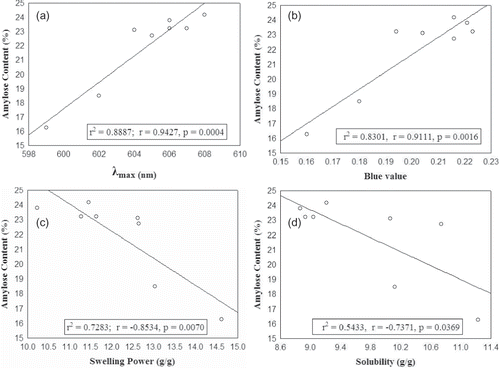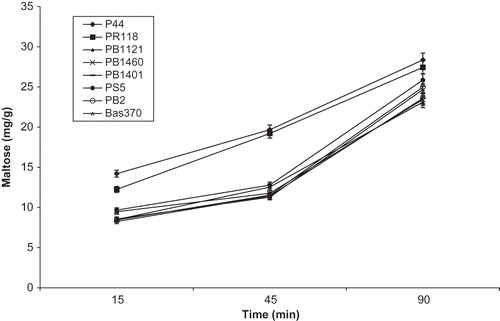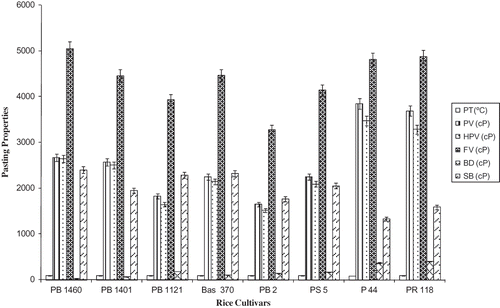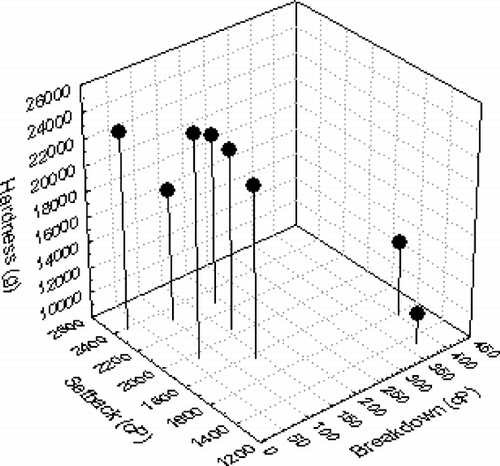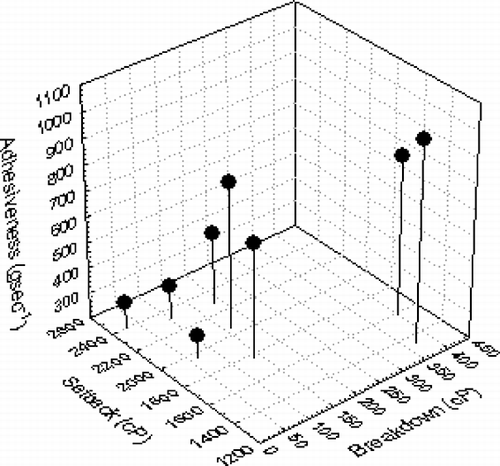Abstract
Grain quality attribute tests based on physicochemical, textural, pasting, and in vitro digestion properties of eight different rice cultivars were studied. Basmati varieties showed higher values of amylose content, iodine absorption, blue value, hardness, cohesiveness, pasting temperature, and set back, whereas swelling power, solubility, adhesiveness, peak viscosity, and breakdown values were found to be higher in non-basmati varieties. The release of maltose from basmati rice flour (23.12–25.86 mg/g rice flour) was found to be slower as compared to non-basmati ones (27.43–28.36 mg/g rice flour). Amylose content showed significant correlations with different quality parameters at 5% level of significance.
INTRODUCTION
Rice has been considered as a major staple food of Asia, which provides a large portion of dietary energy. The economic value of rice in specific markets is mainly influenced by the textural properties of the cooked rice as it is mainly consumed as a whole grain.[Citation1] Consumers generally favor certain varieties with value specific appearances, tastes, and texture of cooked rice grains. As in recent times, there has been a steady increase in new processes for products development involving rice as an ingredient,[Citation2] along with characterization of rice grains, the study of physicochemical, thermal, and rheological aspects of rice flour also holds paramount importance in quality determination of rice cultivars along with their flour-based products. Rice flours with different physicochemical properties yield products with different textural qualities. Therefore, an appropriate rice variety must be selected as a raw material to produce different rice-based products. Many studies revealed significant growth in consumption of different cooked rice types, including aromatic, waxy, dry cooking, quick, and parboiled ones.
Quality of milled rice grains and rice-based products is mainly affected by amylose content, gelatinization temperature, processing factors,[Citation3] storage conditions,[Citation4] as well as freezing and thawing conditions. Similarly, the pasting properties of rice flour are key determinants of quality, which significantly impact the final product texture.[Citation5] So, the functional quality of rice can be generally defined in terms of cooking, textural, and in vitro digestion properties of rice grains as well as physicochemical properties of rice flour.
Rice varieties have a broad range of genetic diversity on the basis of grain shape, size, color, and quality parameters.[Citation6] The Indian rice, particularly ‘basmati’, receives a premium position in the market[Citation7] due to high cooked kernel elongation with minimum breadth-wise elongation, high aroma, fluffiness, palatability, and easy digestibility. Recently, genetic improvement of basmati rice varieties has led to the development of a number of high yielding and high quality traits in basmati/aromatic rice varieties (Pusa Basmati 1, Pusa Basmati 1121, Pusa Basmati 1401, Pusa Basmati 1460, Pusa Sugandh 5, and Pusa RH 10).[Citation8] Some medium- and short-grained non-basmati rice varieties generally characterized with opaque appearance, low amylose content and sticky appearance, no aroma, and less elongation ratio after cooking are also famous for the preparation of different rice-based products in food industries. Studies on characterization of quality attributes of these different types of rice varieties are mandatory for the improvement in rice quality worldwide and development of rice-based products. Keeping in view of the above introduction, the present work has been undertaken to study the important quality attributes of some of the popular and newly developed rice varieties of India on which these studies are still meager.
MATERIALS AND METHODS
Procurement of Rice Cultivars
Three paddy cultivars (PR 118, PB 2, and Bas 370) and five paddy cultivars (PB 1401, PB 1460, PS 5, PB 1121, and P 44) were procured from the Punjab Agricultural University, Ludhiana (India) and Indian Agricultural Research Institute, Regional Center, Karnal (India), respectively. Out of these eight cultivars, P 44 and PR 118 were non-basmati and nonaromatic, PS 5 was an aromatic, and PB 2, PB 1121, PB 1460, PB 1401 and Bas 370 were basmati varieties.
Sample Preparation
Paddy seeds of different cultivars were dehusked using a Paddy dehusker (laboratory model, Ambala Associates, Ambala, India), then milled with a rice miller (McGill type, Oswa Industries Pvt. Ltd., Ambala, India). Milled whole rice kernels were separated from broken ones by a rice grader (laboratory model, Ambala Associates, Ambala, India) to get head rice. Rice flour was prepared in a laboratory grinder and passed through 100 mesh to get a uniform particle size.
Physicochemical Properties
Moisture and amylose content
The moisture content of rice flour was determined by a standard method of analysis.[Citation9] The amylose content of rice flour of different samples was determined by the modified method of Juliano.[Citation10]
Iodine absorbance spectra and blue value
Iodine absorption spectra and blue values of rice flour were measured according to the method of Yu et al.[Citation11] First, 1 mL of ethanol (95%) and 9 mL of sodium hydroxide (1 N) was added to 0.1 g of rice flour of each cultivar. The samples were heated on a boiling water bath and after cooling for 1 h, distilled water was added to make up the final volume of 100 mL. About 5 mL of the solution (pH 6.5) was added to 1 mL of iodine solution. Then the λmax were determined by measuring the wavelength of maximum absorbance from 450 to 800 nm with a UV-Vis spectrophotometer (DR 5000, HACH Company, Loveland, CO, USA). Blue value was measured by taking the absorbance at 680 nm and was calculated with the following formula:
Swelling power and solubility
The values for swelling power and solubility were calculated by the method of Leach et al.[Citation12] An aqueous suspension (2%) of rice flour was heated in a water bath for 30 min at 90°C by continuous stirring. Then the suspension was centrifuged at 3000× g for 10 min. Supernatant was taken in petri plates and residues were weighed for swelling power estimation. Supernatant was evaporated in a boiling water bath and the petri plates were dried at 105°C to constant and weighed. Swelling power (SP) and solubility (S) values were calculated by the following formulas:
Characterization of cooking, in vitro digestion, and textural properties
Different cooking parameters were determined by taking 5 g of head rice of different cultivars and dipping in water (1:2) for 30 min in 100-mL beakers before cooking.
Cooked kernel length
Milled grains were cooked in a boiling water bath to their cooking time, which was determined by removing a few kernels at different time intervals during cooking and then pressing between two glass plates till no white core was left.[Citation13] The randomly picked ten cooked kernels were placed lengthwise to determine cooked kernel length (CKL) by millimeter scale.
In vitro digestion of cooked rice grains
In vitro digestion of cooked rice grains was done according to the method of Hettiarachchy et al.[Citation2] with some minor modifications. To start, 20 g of the whole cooked rice samples were blended with 20 mL of distilled water in a 3-oz blender jar. Then, 5 g of the slurry was weighed into a 100-mL Erlenmeyer flask and 10 mL of distilled water was added followed by 10 mL of 0.5 M phosphate buffer (pH 6.9) and 2 mL of 30 mM CaCl2; the flask was swirled for a few seconds to mix. A 5-mL sample was removed into a test tube, and 100 units of α-amylase solution in 1 mM CaCl2 were added. The flask was covered and placed in a shaking water bath at 37°C; a 5 mL sample was removed at 15, 30, and 60 min intervals. The samples were placed in a boiling water bath for 10 min to inactivate the enzyme. After cooling to room temperature, the samples were centrifuged for 15 min at 20,000× g. The supernatant was analyzed for maltose and the results were expressed as mg maltose equivalents per gram sample.
Instrumental Textural Properties
After cooking, the cooked grains were held for 20 min for cooling. Then the upper layer of grains was removed and the grains from the middle layer were picked for texture determination.[Citation14] The texture of cooked grains was determined by a texture analyzer (model TA-XT2i, Texture Technologies Corp., Scarsdale, NY, USA, and Stable Micro Systems, Godalming, Surrey, UK). Five cooked grains were randomly selected and placed on the base plate of the instrument in a single horizontal layer. A compression plate was set at 5 mm above the base. A two-cycle compression was used with a pretest; test and post-test speed was 1 mm/sec. A compression plate of 75 mm diameter with a load cell of 5 kg was used for texture determination of cooked rice samples. Hardness (Hard.), cohesiveness (Coh.), and adhesiveness (Adh.) values were measured from the areas covered under the different peaks. Hardness is defined as the maximum peak force during the first compression cycle. Adhesiveness is defined as the negative force area for the first bite and represents the work required to overcome the attractive forces between the surface of a food and the surface of other materials with which the food comes into contact. Cohesiveness is defined as the ratio of the positive force area during the second compression to that during the first compression.
Pasting Properties
Thermal and pasting properties of rice flour samples of different cultivars were determined by rapid visco analyzer (RVA) Starch Master (Newport Scientific model, Warriewood, NSW, Australia) according to the approved method of the AACC.[Citation15] It determined the thermal properties of rice flour after a specific quantity (3.5 gm, 14% moisture) was added to 25 mL of water in an aluminum cup and the solution was quickly mixed. The measured properties by RVA were pasting temperature (PT), peak viscosity (PV), hot peak viscosity (HPV), final viscosity (FV), breakdown viscosity (BD), and setback viscosity (SB).
Statistical Analysis
All the experiments were repeated thrice by taking different lots of each cultivar every time and the mean value was taken for statistical analysis. The Pearson product moment correlation coefficient for the relationship between different quality parameters was calculated by using Sigma Stat software Window version 3.5 at 5% level of significance (Systat Software, Inc., San Jose, CA, USA). 2D and 3D graphs were designed with the help of Statistica7 software (Statsoft, Inc., Tulsa, OK, USA). Mean values and standard deviations (P < 0.05) were calculated by using Microsoft Office Excel 2003 (Microsoft Corporation, USA).
RESULTS AND DISCUSSION
Amylose Content
Amylose content (AC) of eight rice cultivars showed significant variations between different rice cultivars (). It was in the range of 22–25% for basmati/aromatic rice varieties, whereas for non-basmati, 16–18% amylose content was recorded. The highest value of amylose content was observed in PB 1401 (24.19%), while the lowest belonged to P 44 (16.26%). The traditional basmati (Bas 370) variety has shown low value of amylose as compared to evolved basmati varieties. Generally, amylose and amylopectin in kernels determine the texture of cooked rice and the consumers generally prefer rice with intermediate AC.[Citation16]
Table 1 Physicochemical properties of rice flour of different rice cultivars
Iodine Absorption Spectra and Blue Value
The values for iodine absorption spectra (λmax) and blue value were ranged between 599–608 nm and 0.16–0.223, respectively (). It was observed that values of both parameters (blue value and λmax) were lower in non-basmati varieties as compared to basmati/aromatic varieties. These results indicated that the blue values and λmax values of rice flour were correlated with amylose content, thus the higher the amylose content, the higher the blue value and λmax (). Slight variations in values of these two parameters in basmati varieties might be due to the different cultivars and growing conditions.
Swelling Power and Solubility
It was observed that both swelling power and solubility showed negative correlation with amylose (). The ranges of swelling power and solubility values were 10.23–14.62 and 8.86–11.23 g/g, respectively (). It has been reported that the swelling behavior of cereal starches was mainly correlated to the amylopectin content, while amylose acts as an inhibitor of swelling.[Citation17] During the process of gelatinization of rice starch, some amylose molecules were leached out, which generally depends on molecule structure or hydrogen bonding. Thus, swelling power is not only strictly correlated with amylose content, but also related to amylopectin content. The structure of granules and the distribution of starch molecules in rice starch granules[Citation11] may be responsible for variations in the swelling power and solubility of rice cultivars having similar or nearly similar amylose content.
In Vitro Digestion of Cooked Rice Grains
Differences were observed in the release of maltose during the in vitro digestion of cooked rice grains of basmati/aromatic and non-basmati rice cultivars (). The highest release of maltose has been observed in P 44 (14.21 mg/gm) whereas PB 1401 (8.24 mg/gm) showed the lowest release of maltose during the first 15 min. After 90 min, the highest release of maltose was again observed for P 44 (28.26 mg/gm) but the lowest release was found in PB 1121 (23.12 mg/gm). But in both cases, the rice varieties having high amylose content showed a less amount of maltose released than low amylose varieties () and showed less susceptibility to α-amylase enzyme. This may be due to the effect of other physicochemical properties apart from amylose like starch-protein or starch-lipid complexes and may be due to high gelatinization temperature of basmati varieties.[Citation2] People who are suffering from diabetes or are trying to lose weight should exchange high glycemic index food by those of low or medium glycemic index, which will help them to regulate their blood sugar levels. Thus, incorporation of basmati rice of high amylose content in food can significantly lower the release of sugar in blood compared to non-basmati ones. Similarly, the hydrolysis rate of waxy barley starch by the three correlation amylases at 37°C was observed to be significantly higher than those of normal and high-amylose barley starches.[Citation18]
Table 2 Cooking and textural properties of different rice cultivars
Cooking and Textural Properties
Cooking and textural properties of eight different rice cultivars are given in , in which the length after cooking was observed to be maximum in PB 1121 (18.3 mm) while minimum in P 44 (8.6 mm). The maximum value for hardness was shown by PB 1401 (25,266 g) whereas minimum by P 44 (10,431 g). The values of hardness were observed to be higher in those varieties that have high AC () and have higher cooked kernel length (). The cooked rice hardness has shown a positive with AC (r = 0.895) and CKL (r = 0.899) in . Similarly, a positive correlation between AC and cooked rice firmness (r = 0.526) by sensory as well as instrumental methods has been reported earlierCitation19 In contrast to hardness values, the adhesiveness values were observed to be higher in low amylose cultivars within the range of 829 to 989 g sec− Citation1 (), whereas basmati cultivars showed values in the range of 290 to 649 g sec− Citation1. A high amylose, aromatic variety (PS 5) showed a value of 776 g sec− Citation1 for adhesiveness. The high value of hardness and low values of adhesiveness in basmati/aromatic varieties may be due to the fact that high amylose varieties when cooked have a dry, firm, and fluffy texture as compared to its low amylose counterpart, which has a stickier and glossy appearance.[Citation20,Citation21] The subtle differences observed in textural properties of related varieties may be due to the fact that during cooking, the rice granules absorbed water and swelled to some extent as compared to their original size, which results in the expansion and then rupturing of grains, hence, leaching of solid gruel out of the grains. The amount of starch leaching is generally related to the texture of cooked rice.[Citation22,Citation23] Thus, the instrumental analysis of cooked grains gives better results than sensory methods as it is difficult to assess the various textural parameters of related varieties having similar amylose content, which generally gives very close results when cooked. There were significant differences found in the cohesiveness values of basmati/aromatic and non-basmati cultivars. Basmati varieties showed values in the range of 0.64–0.81, whereas it was in the range of 0.36–0.56 in non-basmati ones. A positive correlation of cohesiveness of cooked rice was observed with amylose content (r = 0.895), hardness (r = 0.879) but negative with adhesiveness (r = −0.867) as shown in . Cohesiveness (the degree to which the rice deforms, rather crumbles or breaks on compression) values were earlier reported to be positively correlated with degree of milling and apparent amylose content.[Citation21]
Table 3 Correlation studies between textural and pasting properties of rice cultivars
Pasting Properties of Different Rice Samples
Diversity in different parameters of pasting properties in basmati/aromatic and non-basmati rice flours, as analyzed by RVA, are shown in . The most important differences between pasting behavior were lower pasting temperature (86.6–87.7°C) and set back viscosities (1105–1434 cP) of non-basmati cultivars than aromatic long grained rice cultivars that have higher values of pasting temperature (89.9–97.6°C) and setback values (1756–2433 cP), which may be due to their high amylose content. Similarly, the basmati/aromatic cultivars had shown lower peak (1634–2698 cP), hot paste (1527–2685 cP), and breakdown (13–171 cP) viscosities than non-basmati ones, which have the values of peak, host paste, and breakdown viscosities ranging between 3642–3831, 3270–3469, and 362–372 cP, respectively. During the heating process, the starch granules start to swell and burst, the semi-crystalline structure is lost, and the smaller amylose molecules start leaching out of the granule, forming a network that holds water, thus increasing the mixture's viscosity. It was also reported earlier that low amylose rice cultivars exhibited higher peak viscosity, breakdown,[Citation24] and lower setback.[Citation25] In , the positive correlation of AC with setback (r = 0.803), negative with breakdown (r = −0.874), and peak viscosity (r = −0.874) confirms the findings of previous researchers. Amylose content is a key element for characterizing a rice cultivar for cooking quality; however, cultivars with similar or comparable amylose content had also shown variations in major parameters of flour pasting properties, which clearly signifies the importance of RVA for measuring pasting properties of those varieties that have similar or related amylose content. Between basmati cultivars, the order of setback values was PB 1460 > Bas 370 > PB 1121 > PB 1401 > PB 2. Hence, the amylose content alone was not responsible for the pasting properties.[Citation26] High values of final viscosity (4203.0 cP), setback value (756 cP), and pasting temperature (80.8°C) were observed in SM (high amylose variety) than SN2 (low amylose variety) having values of 1611.0 cP, 1527.5 cP, and 67.27°C, respectively.[Citation11]
Relationship Between Texture Profile and Pasting Behavior
Significantrelationships observed in textural and pasting behavior of rice samples are shown in . Hardness of cooked rice showed a significant and positive correlation with PT (r = 0.853) but negative with BD (r = −0.911) and PV (r = −0.734). The hardness showed a positive relationship with setback, though it was not significant. A reverse trend of firmness of cooked rice with breakdown viscosity of rice starch has been also observed earlier.[Citation27] Adhesiveness of cooked rice showed a positive correlation with BD (r = 0.862) but negative with setback (r = −0.821). On the basis of relationship between hardness, adhesiveness, breakdown, and setback values, there was remarkable clustering of two groups set up in the figures ( and ) in which six basmati/aromatic varieties had formed one cluster, whereas two non-basmati and non aromatic varieties had formed another cluster.
CONCLUSIONS
Significant differences were observed in physicochemical, in vitro digestion, and textural and pasting properties of basmati/aromatic and non-basmati rice cultivars having high and low amylose content, respectively. Instrumental analysis proved to be an efficient tool to differentiate the textural and pasting properties of closely related varieties having little differences in their amylose content. Textural and pasting properties showed significant correlation with each other and with amylose content. These experimental results would provide useful information for the food and other industries making use of low, medium, and high amylose rice cultivars for further quality improvements and in the development of rice-based products.
REFERENCES
- Chung , W.K. , Han , A. , Saleh , M. and Meullenet , J.F. 2004 . “ Prediction of long-grain rice texture from pasting properties ” . In B.R. Wells Arkansas Rice Research Studies 2003 , Edited by: Norman , R.J. , Meullenet , J.F. and Aoledenhauer , K.A.K. Vol. 517 , 355 – 361 . University of Arkansas Agriculture Experiment Research Series .
- Hettiarachchy , N.S. , Griffin , V.K. , Gnanasambandam , R. , Moldenhauer , K. and Siebenmorgen , T. 1997 . Physicochemical properties of three rice varieties . Journal of Food Quality , 20 : 279 – 289 .
- Meullenet , J.F. , Gross , J. , Marks , B.P. and Daniel , M. 1998 . Sensory profiling of cooked rice and its correlation to instrumental parameters using an extrusion cell . Cereal Chemistry , 75 : 714 – 720 .
- Zhou , Z.K. , Robards , K. , Helliwell , S. and Blanchard , C. 2003 . Effect of rice storage on pasting properties of rice flour . Food Research International , 36 : 625 – 634 .
- Vongsawasdi , P. , Noppharat , M. , Hiranyaprateep , N. and Tirapong , N. 2009 . Relationships between rheological properties of rice flour and quality of vermicelli . Asian Journal of Food and Agro-Industry , 2 : 102 – 109 .
- Thongbam , P.D. , Durai , A.A. , Singh , T.A. , Taorem , B.D. , Gupta , S. , Mitra , J. , Pattanayak , A. , Dhiman , K.R. , Bhadana , V.P. , Hore , D.K. and Ngachan , S.V. 2010 . Grain and food quality traits of some indigenous medicinal rice cultivars of Manipur, India . International Journal of Food Properties , 13 : 1244 – 1255 .
- Ritika , B.Y. , Khatkar , B.S. and Yadav , B.S. Physicochemical . 2010 . morphological, thermal and pasting properties of starches isolated from rice cultivars grown in India . International Journal of Food Properties , 13 : 1339 – 1354 .
- Singh , A.K. , Gopalakrishnan , S. , Singh , V.P. , Prabhu , K.V. , Mohapatra , T. , Singh , N.K. , Sharma , T.R. , Nagarajan , M. , Vinod , K.K. , Singh , D. , Singh , U.D. , Chander , S. , Atwal , S.S. , Seth , R. , Singh , V.K. , Ellur , R.K. , Singh , A. , Anand , D. , Khanna , A. , Yadav , S. , Goel , N. , Singh , A. , Shikari , A.B. , Singh , A. and Marathi , B. 2011 . Marker assisted selection: a paradigm shift in Basmati breeding . Indian Journal of Genetics , 71 : 120 – 128 .
- AOAC . 1984 . Official Methods of Analysis of Association of Official Analytical Chemists , 14th , Arlington , VA : AOAC .
- Juliano , B.O. 1971 . A simplified assay for milled rice amylose . Cereal Science Today , 16 : 334 – 340 .
- Yu , S. , Ma , Y. , Menager , L. and Sun , D.W. 2010 . “ Physicochemical properties of starch and flour from different rice cultivars ” . In Food and Bioprocess Technology doi: DOI 10.1007/s11947-010-0330-8
- Leach , H.W. , McCowen , L.D. and Schoch . 1959 . T.J. Structure of the starch granule . I. Swelling and solubility patterns of various starches. Cereal Chemistry , 36 : 534 – 544 .
- Juliano , B.O. and Bechtel , D.B. 1985 . “ The rice grain and its gross compositionn ” . In Rice: Chemistry and Technology , Edited by: Juliano , B.O. 17 – 50 . MN : American Association of Cereal Chemists: St. Paul .
- Champagne , T.E. , Lyon , B.G. , Min , B.K. , Vinyard , B.T. , Bett , K.L. , Barton , F.E. II , Webb , B.D. , McClung , A.M. , Moldenhauer , K.A. , Linscombe , S. , Mckenzie , K.S. and Kohlwey , D.E. 1998 . Effects of postharvest processing on texture profile analysis of cooked rice . Cereal Chemistry , 75 : 181 – 186 .
- Approved Methods of the American Association of Cereal Chemists , 9th , 1995 St.Paul , MN : American Association of Cereal Chemists . AACC. Method 61-02.
- Bhonsle , S.J. and Sellappan , K. 2010 . Grain quality evaluation of traditionally cultivated rice varieties of Goa , Vol. 26 , 88 – 97 . India : Recent Research in Science and Technology .
- Singh , N. , Kaur , L. , Sandhu , K.S. , Kaur , J. and Nishinari , K. 2006 . Relationships between physicochemical, morphological, thermal, rheological properties of rice starches . Food Hydrocolloids , 20 : 532 – 542 .
- Li , J.H. , Vasanthan , T. , Hoover , R. and Rossnagel , B.G. 2003 . Starch from hull-less barley: V. In-vitro susceptibility of waxy, normal, and high-amylose starches towards hydrolysis by alpha-amylases and amyloglucosidase . Food Chemistry , 84 : 621 – 632 .
- Sowbhagya , C.M. , Ramesh , B.S. and Bhattacharya , K.R. 1987 . The relationship between cooked rice texture and the physiochemical characteristics of rice . Journal of Cereal Sciences , 5 : 287 – 297 .
- Noda , T. , Nishiba , Y. , Sato , T. and Suda , I. 2003 . Properties of starches from several low-amylose rice cultivars . Cereal Chemistry , 80 : 193 – 197 .
- Mohapatra , D. and Bal , S. 2006 . Cooking quality and instrumental textural attributes of cooked rice for different milling fractions . Journal of Food Engineering , 73 : 253 – 259 .
- Chiang , P.Y. and Yeh , A.I. 2002 . Effect of soaking on wet-milling of rice . Journal of Cereal Science , 35 : 85 – 94 .
- Ong , M.H. and Blanshard , J.M.V. 1995 . Texture determinants in cooked, parboiled rice. I: Rice starch amylose and the fine structure of amylopectin . Journal of Cereal Science , 21 : 251 – 260 .
- Gupta , M. , Bawa , A.S. and Semwal , A.D. Morphological . 2009 . thermal, pasting and rheological properties of barley starch and their blends . International Journal of Food Properties , 7 : 329 – 340 .
- Kuno , M. , Kainuma , K. and Takahashi , S. 2000 . Physicochemical characteristics of low amylose rice starches . Oyo Toshitsu Kagaku , 47 : 319 – 326 .
- Cameron , D.K. and Wang , Y.J. 2005 . A better understanding of factors that affect the hardness and stickiness of long-grain rice . Cereal Chemistry , 82 : 113 – 119 .
- Limpisut , P. and Jindal , V.K. 2002 . Comparison of rice flour pasting properties using Brabender Visco Amylograph and Rapid Visco Analyzer for evaluating cooked rice texture . Starch/Starke , 54 : 350 – 357 .

